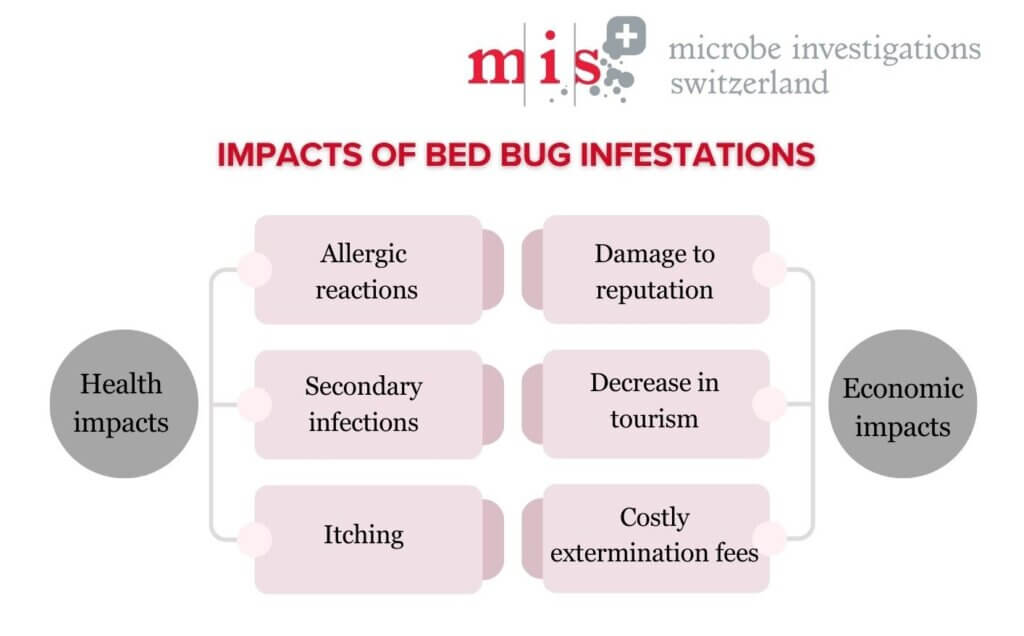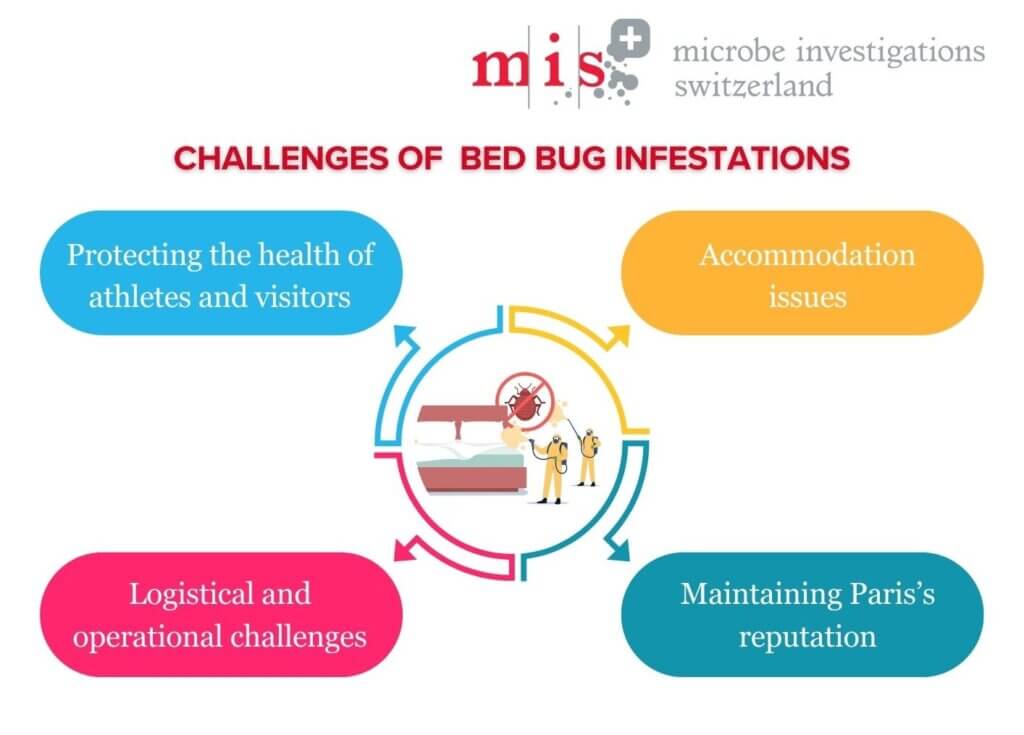As Paris prepares to host the upcoming Olympics a minute but formidable adversary lurks within the fabric of the city – bed bugs. These tiny fast-breeding pests are becoming a bigger problem for both residents and visitors. This article explores the impacts of bed bugs on public health and the economy, the challenges they pose for the upcoming Olympics and the measures being taken to address them.
What are Bed Bugs?
Bed bugs (Cimex lectularius) are small, nocturnal insects that feed on human blood leaving itchy, red bites on their hosts. They are skilled at hiding in small openings and cracks and have a rapid reproduction rate making them difficult to detect and eliminate.
The bed bug’s resistance to conventional pesticides, the increase in tourism and the decrease in the use of potent pesticides due to health and environmental concerns have led to the reemergence of bed bugs in urban areas.
Growing bed bug concern in Paris
Paris with its high population and status as a global travel hub has seen a rapid increase in bed bug infestations. Hotels, residential buildings and even public transportation are facing bed bug issues. This has raised considerable concerns among residents and visitors. This problem has grown to such an extent that it has gained attention from local authorities and public health officials who are constantly working on addressing the issue.
What are the impacts of bed bug outbreak on public health and economy?
- Impact of Bed Bugs on Public Health
Although bed bugs are not known to transmit diseases their bites can cause itching, allergic reactions and secondary infections. Their infestations can have psychological impacts leading to stress, anxiety and sleep disturbances.
- Impact of Bed Bugs on Economy
Bed bug infestations majorly impact the hospitality and tourism sectors. Hotels and rental properties face costly extermination fees, compensation claims and damage to their reputation due to these infestations. Increased bed bug infestations can also lead to a decrease in tourism which affects Paris’ economy.

Upcoming Paris Olympics and the rising concern of bed bugs
- Accommodation issues- With millions of visitors from various countries arriving in Paris for the Olympics the demand for accommodation will increase. This presents a dual challenge of making sure to provide sufficient pest-free housing for visitors and preventing the further spread of bed bugs through increased human movement.
- Protecting the health of athletes and visitors- The presence of bed bugs can have negative effects on both the physical and psychological health of people. This in turn impacts the athlete’s performance during the Olympics and visitor satisfaction. Keeping accommodations clean and safe requires careful planning and teamwork among those providing places to stay.
- Logistical and operational challenges- Addressing bed bugs involves overcoming logistical and operational challenges particularly with the expected visitor surge. Accommodation providers must improve inspection and maintenance protocols which could be costly. Additionally, it is important to manage infestations discreetly to prevent panic. This adds to the existing challenges.
- Maintaining Paris’s reputation- With Paris under the international spotlight, any issues including bed bugs will be intensified. The Olympics offer Paris a chance to showcase its attractions and hospitality. Successful management of bed bug issues can increase its global reputation while failure might damage its image affecting future tourism and events.

Control measures
A comprehensive strategy is required to address bed bug infestations.
- educating the public on prevention measures,
- adopting strict pest control measures in public and private spaces,
- conducting regular inspections,
- use of bed bug-proof encasements for beds and pillows,
- use of effective bed bug repellents and
- the development of rapid response teams to manage outbreaks.
For the Olympics, specific protocols must be established for accommodation providers including regular inspections and the immediate treatment of affected areas.
Standard test methods used for product efficacy testing against bed bug
Use of effective bed bug repellents is the key to preventing bed bug infestations. These bed bug repellents must undergo strict testing to validate their efficacy in preventing the spread of bed bugs. Standard tests for bed bug repellency testing are designed to evaluate the effectiveness of materials or chemical compounds in preventing bed bug infestation. The tests differ based on the scope of application but generally include the following methodologies:
- Petri dish repellency assay: This test measures the repellency of treated surfaces by observing the movement patterns of bed bugs. In this test bed bugs are placed in a container with a treated surface on one side and a control surface on the other and then their distribution is measured after a set period.
- No choice (Barrier) test: This method tests the ability of a repellent to prevent bed bugs from feeding. It involves offering bed bugs a blood meal through a membrane treated on one side with the repellent and the other left untreated. The effectiveness of the repellent is indicated by observing the reduction in feeding on the treated side compared to the control.
- Harborage choice test: This test determines the repellency of materials by giving bed bugs a choice between treated and untreated harborage areas. Observations are made to determine which areas the bed bugs prefer for hiding with a preference for untreated areas indicating repellent effectiveness.
- Residual efficacy test: The residual efficacy test is used to evaluate how long the product’s effectiveness remains after application. In this test surfaces are treated with the repellent product. After treatment, the bed bugs are introduced to determine the knockdown effect over time.
- Olfactory test: The olfactory test can be used to determine the effectiveness of bed bug-repellent products.
- In this test a modified still-air olfactometer is used. This device contains carbon dioxide and a heat source to mimic a human host.
- The efficacy is determined by observing the movement patterns of the bugs when the repellent is present and when it is absent.
- Field tests: Field tests are conducted on repellents in order to determine their effectiveness in practical situations. This includes testing the products at homes and hotels having different levels of infestations.
- Collection of data on the infestation levels before the application of repellent products is the first step while conducting field tests.
- Next the repellent is applied according to the instructions provided by the manufacturers.
- The product efficacy is observed via visual inspections, interceptor devices, and by obtaining feedback from participants regarding incidents of bites.
- A control group without repellent treatment is used for comparison.
- Data is statistically analyzed to determine the repellent’s performance.
- Feedback on usage and the repellent’s side effects is collected from participants.
How can MIS help with bed bug testing services?
Microbe Investigations Switzerland (MIS) can play an important role in preventing bed bug infestations through their expertise in bed bug testing. By implementing in-depth knowledge and latest testing methods, MIS can identify effective repellents and treatments that can be applied to textiles and surfaces within accommodations.
At MIS, we provide a comprehensive range of entomology testing services tailored for various sectors involved in the manufacture of insecticides for home use, agriculture, disease vector control, and industrial applications.
Our team of entomology specialists employ testing techniques that are broadly recognized and adhere to the highest industry standards, ensuring a thorough evaluation.
For more information on our entomology testing services or to receive a quote on our bed bug repellency test services, please contact our experts.









